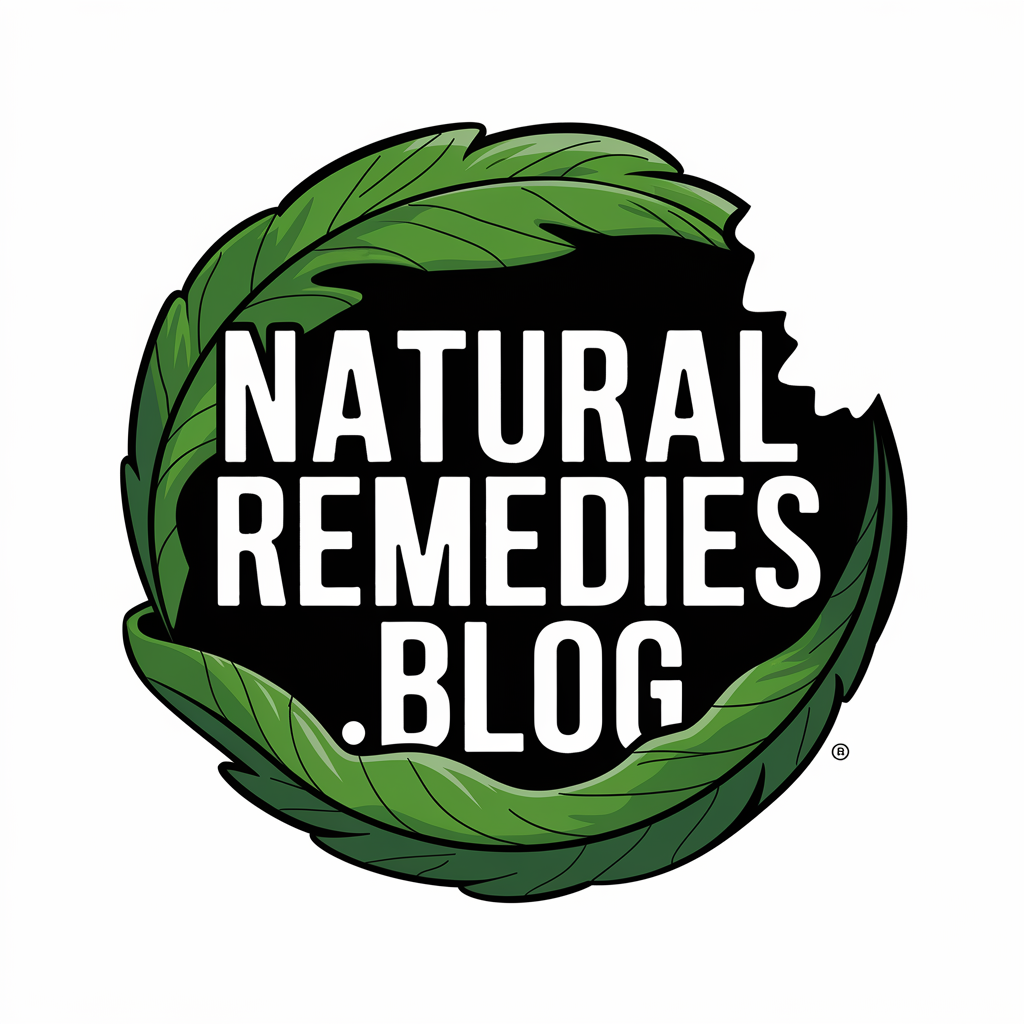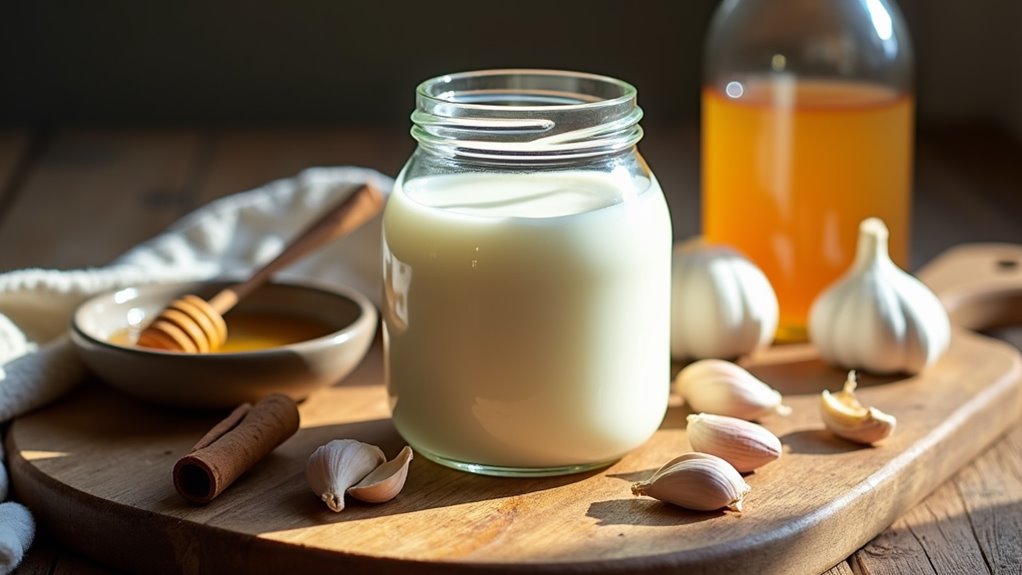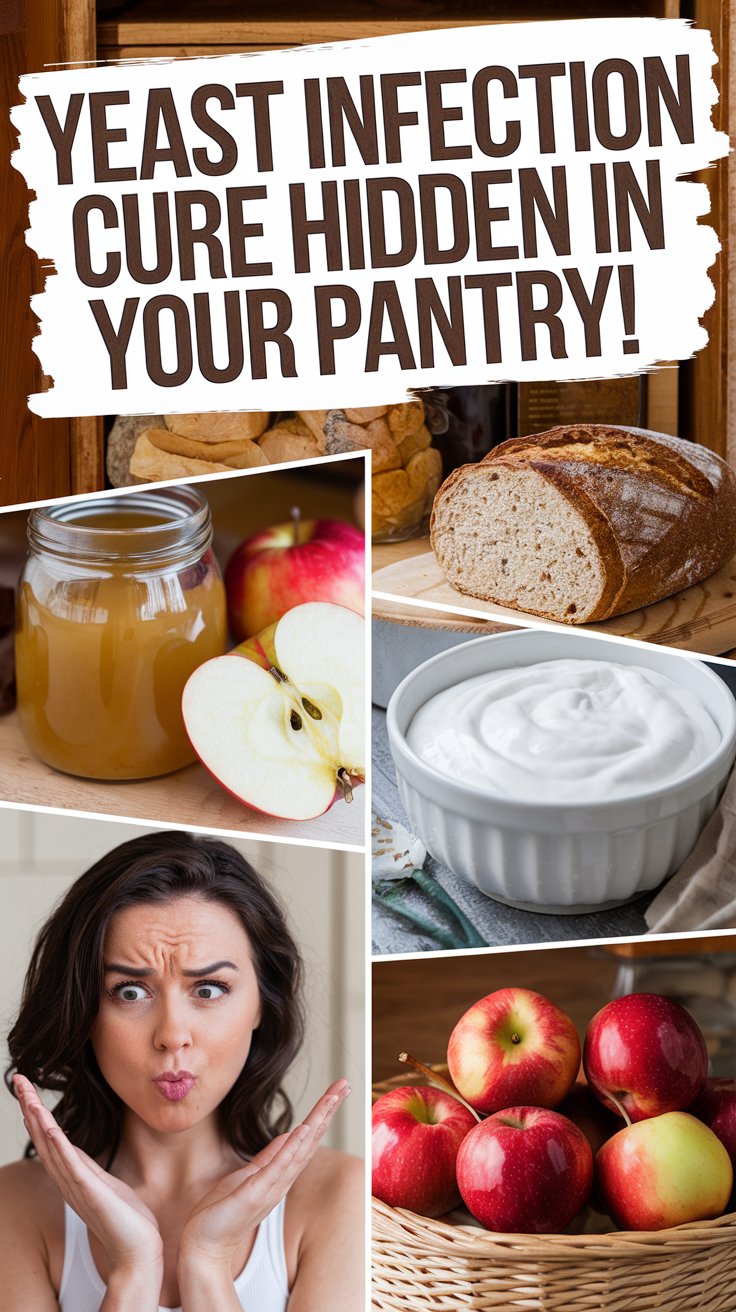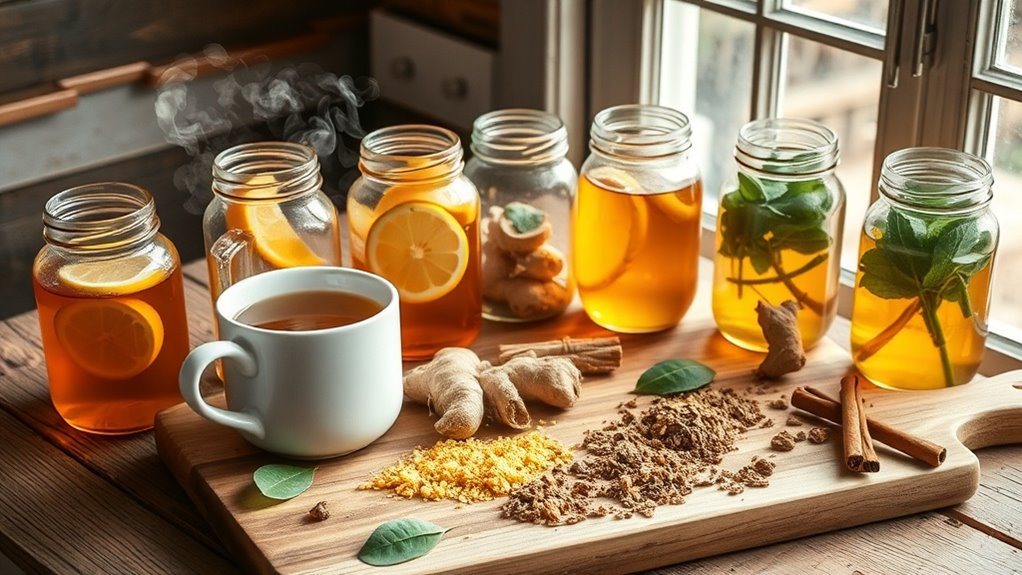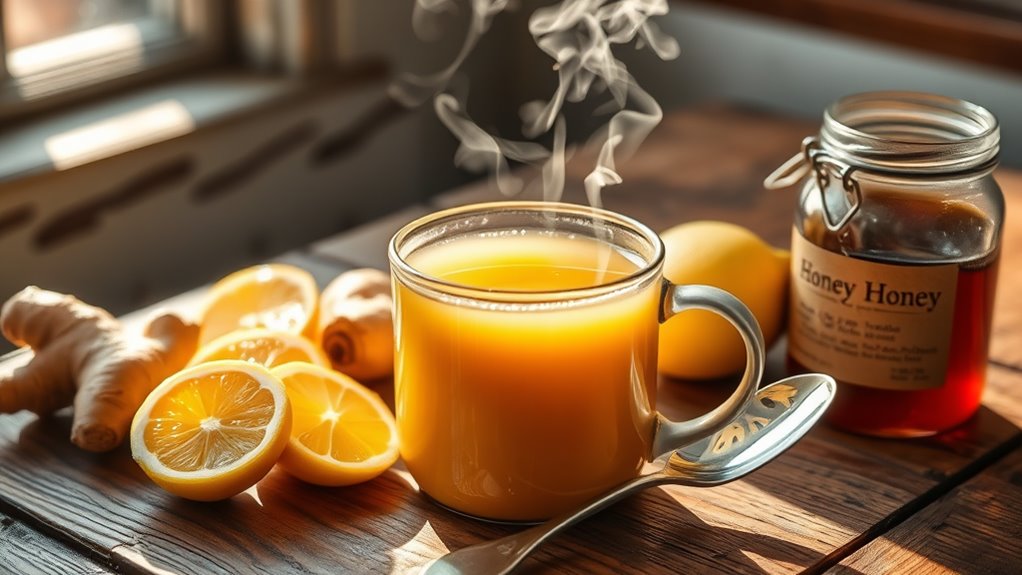Yeast Infection Cure Hidden in Your Pantry!
You’ve likely got powerful yeast infection remedies hiding in your kitchen right now. Natural antifungals like coconut oil, garlic, and apple cider vinegar can effectively combat Candida overgrowth with their potent compounds. Try applying diluted apple cider vinegar topically, using coconut oil as a soothing treatment, or harnessing garlic’s antimicrobial properties. While these pantry staples offer relief, understanding the science behind their healing power will maximize your success.
Key Takeaways
-
Coconut oil contains natural antifungal compounds that disrupt fungal cell membranes and can be applied directly to affected areas.
-
Fresh garlic cloves possess potent allicin that breaks down yeast cell walls when used overnight with regular changes.
-
Apple cider vinegar restores pH balance through soaking baths or diluted applications to affected areas.
-
Common kitchen herbs like oregano, thyme, and sage contain natural antifungal properties that fight yeast infections.
-
Cinnamon and turmeric work together to prevent Candida from forming biofilms and reproducing effectively.
Understanding Yeast Infections: Signs and Symptoms
Candida, a type of fungus naturally present in your body, can sometimes grow out of control and cause a yeast infection.
You’re not alone if you’re experiencing common symptoms like intense itching, burning sensations, and unusual discharge. Many women face this uncomfortable condition and search for yeast infection remedies fast.
You’ll likely notice a thick, white, cottage cheese-like discharge along with redness and swelling around your vaginal area.
Some women also experience pain during urination or intercourse. If you’re dealing with these symptoms, you might feel embarrassed, but remember that yeast infections are incredibly common.
While mild cases often clear up within a few days with proper treatment, persistent or recurring symptoms warrant a visit to your healthcare provider to guarantee accurate diagnosis and treatment.
The Science Behind Natural Antifungal Ingredients
While treating yeast infections medically is common, nature offers powerful antifungal compounds that can help combat Candida overgrowth. You’ll find these healing ingredients right in your kitchen, backed by scientific research.
Coconut oil contains caprylic acid, which disrupts fungal cell membranes and prevents Candida from thriving.
Garlic’s allicin compound works similarly, breaking down yeast cell walls.
Tea tree oil’s terpenes penetrate fungal cells, while oregano oil’s carvacrol component destroys harmful microorganisms.
Your pantry’s cinnamon and turmeric contain active compounds that inhibit Candida’s ability to form biofilms and reproduce.
Apple cider vinegar’s acetic acid creates an unfavorable environment for yeast growth, while helping restore your body’s natural pH balance.
These natural solutions have helped countless others in your situation find relief.
Apple Cider Vinegar: Nature’s Antifungal Solution
For centuries, people have turned to apple cider vinegar as a trusted natural remedy for yeast infections.
You’ll find that its powerful antifungal properties come from acetic acid, which helps restore your body’s natural pH balance and creates an environment where yeast can’t thrive.
To use this pantry staple, you can add two tablespoons of raw, unfiltered apple cider vinegar to your warm bath water and soak for 20 minutes.
You’re also welcome to try the diluted solution method – mix one part vinegar with three parts water and apply it gently to affected areas.
Many in our natural healing community swear by drinking it too – just mix one tablespoon with a glass of water daily.
Coconut Oil’s Powerful Healing Properties
When it comes to fighting yeast infections naturally, coconut oil stands out as one of nature’s most effective remedies. This amazing oil contains caprylic acid, lauric acid, and capric acid – three powerful compounds that work together to combat Candida overgrowth.
You’ll love how easy it’s to use coconut oil. Simply apply a thin layer of organic, unrefined coconut oil to the affected area twice daily.
Many women in our natural health community have found relief within just a few days of starting this treatment. As an added bonus, coconut oil’s moisturizing properties help soothe irritated skin while fighting the infection.
Garlic: The Ancient Yeast-Fighting Remedy
Another powerful natural remedy alongside coconut oil is garlic, which has been used to fight infections for thousands of years.
This common kitchen staple contains allicin, a potent compound that’s proven effective against Candida albicans, the fungus responsible for yeast infections.
You’ll find that garlic’s natural antifungal properties work best when you use it fresh. Simply peel a clove, make a few small cuts to release the beneficial compounds, and insert it overnight.
Many women in our community have found success with this time-tested method. While you might notice a distinct garlic taste in your mouth (yes, that happens!), the relief you’ll experience makes it worthwhile.
Just remember to change the clove every 12 hours and discontinue use if you experience any irritation.
Tea Tree Oil and Essential Oil Blends
Tea tree oil stands out as one of nature’s most potent antifungal remedies for yeast infections.
You’ll find this powerful essential oil effectively fights Candida while soothing irritated skin. When using tea tree oil, always dilute it with a carrier oil like coconut or olive oil to prevent skin sensitivity.
For enhanced results, you can create your own healing blend by combining tea tree oil with other antifungal essential oils.
Try mixing 3 drops of tea tree oil with 2 drops of lavender and 1 drop of oregano oil in 2 tablespoons of coconut oil. This combination not only fights the infection but also reduces discomfort and inflammation.
You’re joining countless others who’ve discovered these natural solutions that have been trusted for generations.
Greek Yogurt’s Probiotic Benefits
Beyond topical treatments, Greek yogurt offers powerful internal support for fighting yeast infections. The probiotics, especially Lactobacillus acidophilus, help restore your body’s natural balance of good bacteria.
You’ll find these beneficial microorganisms work tirelessly to keep harmful yeasts in check.
When choosing Greek yogurt, look for brands that say “live active cultures” on the label. You’ll want to consume at least one serving daily during an infection and as preventive care.
Make sure it’s plain, unsweetened yogurt since sugar can feed yeast growth. If you’re not a fan of yogurt’s taste, try mixing it with a handful of berries or a drizzle of honey.
You’re joining countless others who’ve discovered this natural remedy that’s been trusted for generations.
Cranberry: More Than Just a UTI Treatment
While many people know cranberries for their UTI-fighting properties, these tart berries also pack powerful antifungal compounds that help combat yeast infections.
You’ll find that cranberries contain proanthocyanidins, which prevent harmful yeasts from sticking to your body’s tissues.
You can easily incorporate cranberries into your yeast infection treatment plan. Add unsweetened cranberry juice to your daily routine, or take cranberry supplements from your local health store.
Just remember that you’ll want to avoid sweetened versions, as sugar can actually feed the yeast and worsen your infection.
For best results, join the many women who combine cranberry treatments with other natural remedies like probiotics.
You’re not alone in seeking natural solutions, and you’ll find that this powerful berry can be a valuable ally in your healing journey.
Kitchen Herbs That Combat Yeast Growth
Your kitchen spice rack holds powerful allies against yeast infections. Common herbs like oregano, thyme, and sage contain natural antifungal compounds that help fight Candida overgrowth.
You’ll find these familiar seasonings particularly effective when combined with other natural treatments.
Garlic, a kitchen staple, packs potent antimicrobial properties that make it a go-to remedy in many households. Simply adding two crushed cloves to your daily meals can boost your body’s defenses.
Turmeric and cinnamon, warming spices you might already use, also help restore balance to your system.
You don’t need to look further than your pantry to find these trusted remedies. Many women have discovered relief using these traditional kitchen herbs, proving that effective treatments can be both natural and accessible.
Creating Your Own Natural Treatment Paste
Making an effective natural treatment paste starts with selecting the right combination of antifungal ingredients from your kitchen. You’ll find creating your own remedy empowering and cost-effective, plus you’ll know exactly what’s in it.
| Base | Active Ingredient | Binding Agent |
|---|---|---|
| Coconut Oil | Garlic | Aloe Vera |
| Greek Yogurt | Oregano | Raw Honey |
| Apple Cider Vinegar | Turmeric | Beeswax |
| Olive Oil | Tea Tree Oil | Shea Butter |
| Almond Oil | Cinnamon | Cocoa Butter |
Mix one item from each column to create your custom paste. Start with one tablespoon of your chosen base, add half a teaspoon of the active ingredient, and blend with one teaspoon of the binding agent. Store your mixture in a clean, airtight container and apply twice daily for best results.
Dietary Changes to Prevent Future Infections
Since recurring yeast infections often stem from diet choices, implementing strategic nutritional changes can greatly reduce future outbreaks.
You’ll want to eliminate foods that feed yeast, like refined sugars, white flour, and alcohol. Instead, fill your plate with probiotic-rich foods such as yogurt, kimchi, and sauerkraut to support healthy gut flora.
Add immune-boosting foods to your daily menu – garlic, ginger, and coconut oil contain natural antifungal properties that help fight yeast overgrowth.
You’re also going to benefit from increasing your fiber intake through vegetables and whole grains, which help maintain balanced blood sugar levels.
Don’t forget to drink plenty of water and unsweetened cranberry juice to help flush out harmful bacteria and maintain proper pH levels in your body.
Honey’s Antimicrobial Properties
Raw honey’s remarkable antimicrobial properties make it an effective natural remedy for yeast infections. You’ll find that honey contains natural hydrogen peroxide, enzymes, and a high sugar concentration that creates an inhospitable environment for Candida growth.
When you choose honey for treatment, always opt for raw, unprocessed varieties, as they retain their full therapeutic potential.
Like many natural health enthusiasts, you can apply a thin layer of medical-grade honey to external areas affected by yeast overgrowth. The honey’s low pH and osmotic effect help restore your body’s natural balance while providing soothing relief.
You’ll appreciate that honey also supports your immune system, helping your body fight off the infection from within when consumed in moderation as part of your daily wellness routine.
Safe Application Methods for Home Remedies
When applying natural remedies like honey for yeast infections, proper technique assures both safety and effectiveness. You’ll want to verify your hands and application tools are thoroughly clean before beginning any treatment. Remember, you’re part of a community seeking natural solutions, so following these tested methods will help you achieve the best results.
| Application Method | Safety Tips |
|---|---|
| Direct Application | Use organic, unpasteurized honey; avoid if diabetic |
| Mixed Solution | Dilute with warm water; test on small area first |
| Compress | Use clean cotton cloth; replace every 4-6 hours |
Always do a patch test 24 hours before trying any new remedy. If you experience burning, itching, or discomfort, discontinue use immediately and consult your healthcare provider. With proper application, you’ll join countless others who’ve found relief through natural treatments.
When to Combine Natural Treatments
Although natural remedies can work well individually, combining certain treatments may enhance their effectiveness against yeast infections.
You’ll find that pairing coconut oil with garlic or tea tree oil with yogurt can create powerful antifungal combinations. Just remember to test these mixtures on a small area first to verify you don’t have any sensitivities.
The best time to combine treatments is when you’re experiencing mild to moderate symptoms that haven’t responded to single remedies.
Start with two complementary ingredients – like apple cider vinegar baths alongside probiotic supplements.
You’re part of a community that values natural healing, but always listen to your body. If symptoms persist or worsen after trying combined treatments for three days, it’s time to consult your healthcare provider.
Storage Tips for Natural Remedies
Proper storage of natural remedies guarantees their potency and prevents contamination. You’ll want to keep your natural treatments in airtight containers away from direct sunlight and moisture.
Store tea tree oil, coconut oil, and other liquid remedies in dark glass bottles to protect them from light degradation.
For dried herbs like oregano and calendula, use sealed glass jars and place them in a cool, dark cabinet.
You’ll need to check your remedies regularly for any signs of mold or unusual odors. Most natural treatments will stay fresh for about six months when stored correctly.
Label each container with the contents and date of preparation, so you’ll always know what you’re using and when it’s time to replace them.
Potential Side Effects and Precautions
Despite being natural, home remedies for yeast infections can cause adverse reactions in some people. You’ll need to watch for signs of allergic reactions, including rash, itching, or swelling. If you experience any of these symptoms, stop using the remedy immediately and consult your healthcare provider.
You should never try natural treatments if you’re pregnant, nursing, or have a compromised immune system without first checking with your doctor.
While yogurt and tea tree oil are popular remedies, they can sometimes worsen your symptoms or interact with medications you’re taking. Remember, what works for others in your community mightn’t work for you.
If your symptoms persist beyond a week or become severe, don’t hesitate to seek medical attention – your health and safety come first.
Tracking Your Treatment Progress
When treating a yeast infection, keeping a daily log of your symptoms helps you monitor your progress and identify what’s working.
Record any itching, burning, discharge changes, or discomfort levels on a scale of 1-10. You’ll want to note the time you apply treatments and any immediate reactions.
Take photos of visible symptoms if you’re comfortable, as these can help you track subtle changes that you might miss day-to-day.
Many people find it helpful to use their phone’s notes app or a dedicated health tracking app. Be sure to document any dietary changes or new products you’re using alongside your treatment.
If symptoms worsen or don’t improve after a week, your log will provide valuable information to share with your healthcare provider.
When to Seek Professional Medical Help
Although many yeast infections clear up with over-the-counter treatments, you’ll need to contact your healthcare provider if symptoms persist beyond 7 days or worsen after starting treatment.
You should also seek medical attention if you’re experiencing severe pain, extensive redness, or unusual discharge with a strong odor. These could indicate a more serious condition or resistant infection that requires prescription medication.
If you’ve had four or more yeast infections within a year, it’s important to get checked out, as frequent infections may signal an underlying health issue.
Don’t hesitate to call your doctor if you’re pregnant, have a weakened immune system, or aren’t sure whether your symptoms are actually from a yeast infection.
Frequently Asked Questions
Can I Use These Natural Remedies During Pregnancy?
You should always check with your doctor before trying any natural remedies during pregnancy. What’s safe when you’re not pregnant may pose risks to your developing baby.
How Long Should I Wait Between Trying Different Natural Treatments?
You’ll want to wait 2-3 days between trying different natural remedies. This gives your body time to respond and helps you identify which treatments are working for you.
Will These Remedies Stain My Underwear or Clothing?
Some natural remedies can leave stains, so you’ll want to wear old underwear during treatment. Using a pantyliner helps protect your clothes and lets you track any changes.
Can Men Use These Natural Treatments for Yeast Infections Too?
While men can get yeast infections, you’ll want to check with your doctor first. Natural treatments may help, but men’s infections often need different approaches than women’s remedies.
Should I Refrigerate Homemade Natural Remedies After Mixing Ingredients Together?
You’ll want to store most homemade remedies in the fridge, as they don’t contain preservatives. Keep them in an airtight container and use them within 3-5 days for best results.
